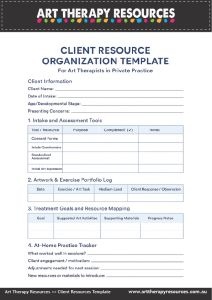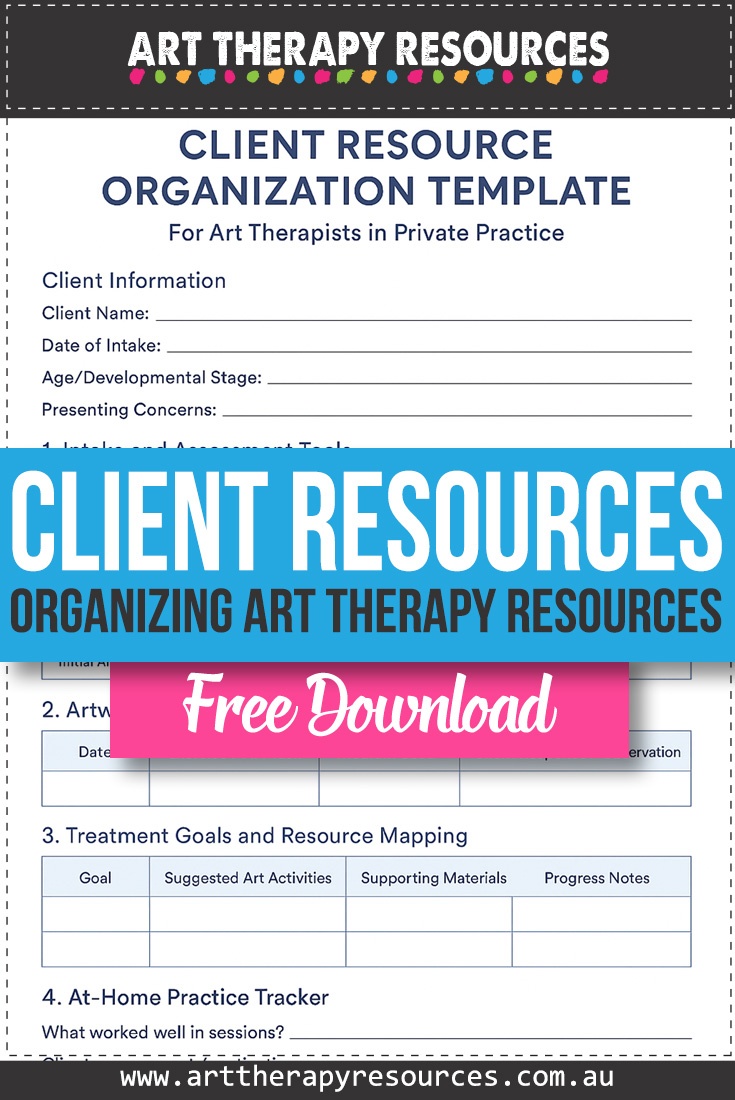THIS POST INCLUDES:
1. Structuring Physical and Digital Materials
2. Aligning Resources with Client Goals
3. Integrating Psychoeducational and Self-Help Tools
4. Free Download Client Resource Organization Template
Structuring Physical and Digital Materials
Art therapists working in private practice or clinical settings frequently manage a wide range of client materials, from creative artworks and progress notes to self-help resources and psychoeducational materials. Effectively organizing these resources not only supports efficient practice management but also enhances therapeutic outcomes. Proper resource organization ensures accessibility, consistency, and continuity of care while fostering a professional and ethical practice.
Structuring Physical and Digital Materials
Physical Resource Management: Art therapists often maintain a variety of physical materials, including client artwork, worksheets, prompts, and reference guides. Organizing these materials involves:
- Portfolio Systems: Maintain client artwork and assignments in individual portfolios, clearly labeled with client identifiers and session dates. Consider using acid-free folders or protective sleeves for long-term preservation.
- Categorized Storage: Group materials by type, such as assessment tools, intervention exercises, or psychoeducational handouts, to streamline retrieval.
- Labeling and Indexing: Consistent labeling of shelves, drawers, and boxes allows quick access during sessions, minimizing disruption to the therapeutic flow.
Digital Resource Organization: Increasingly, digital platforms are used to store client information, exercises, and progress tracking:
- Secure Cloud Storage: Utilize encrypted cloud services to store client documents, ensuring compliance with privacy regulations.
- Digital Folders and Tags: Create hierarchical folders and tag documents by client, session, or intervention type. For example, a folder structure might include “Client Name > Assessments > Art Prompts > Session Dates.”
- Version Control: Use software that tracks revisions of digital worksheets or treatment plans to maintain a clear record of changes over time.
Practical Tip: Schedule regular reviews of both physical and digital materials to archive outdated resources, update treatment plans, and remove clutter that may impede efficiency.
Aligning Resources with Client Goals
Aligning Resources with Client Goals
Organizing client resources is most effective when aligned with individualized treatment objectives. Each client’s resource collection should reflect their developmental stage, presenting concerns, and therapeutic priorities.
Assessment and Planning
- Initial Intake Packets: Create standardized intake folders or digital files containing assessment tools, consent forms, and introductory worksheets. This provides consistency across clients and streamlines the intake process.
- Treatment-Specific Materials: Curate resources to match client goals. For example, a client focusing on anxiety management may benefit from emotion-themed art prompts, mindfulness worksheets, and coping skill collage.
Tracking Progress
- Session Notes and Reflections: Maintain structured notes documenting client responses to specific materials and interventions. Linking notes to corresponding artwork or exercises provides an integrated record of therapeutic progress.
- Resource Effectiveness: Regularly evaluate which materials support client engagement and goal achievement, and update the resource library accordingly.
Example: A young adult working on social-emotional skills might use a series of expressive art exercises focusing on self-portraits, empathy collages, and group-based creative tasks. Tracking their responses over time helps the therapist adapt resources for maximum impact.
Integrating Psychoeducational and Self-Help Tools
Integrating Psychoeducational and Self-Help Tools
In addition to session-based art therapy exercises, clients benefit from structured self-help or psychoeducational resources that reinforce skills between sessions.
Curating Client Resources
- Skill Reinforcement Materials: Worksheets, journaling prompts, and visual emotion cards can help clients practice coping strategies outside of sessions.
- Accessible Art Resources: Provide materials that are suitable for at-home use, such as small sketchbooks, coloring guides, or digital art prompts.
- Resource Customization: Tailor materials to each client’s interests, developmental stage, and emotional needs to maximize engagement.
Documentation and Follow-Up
- Tracking Usage: Encourage clients to bring completed exercises to sessions or document at-home activities digitally. This provides tangible evidence of skill development.
- Feedback Loop: Incorporate client reflections on their use of resources into treatment planning to ensure that resources remain relevant and effective.
- Practical Tip: Consider creating a “Client Resource Binder” or digital equivalent that can be updated session by session. Include sections for psychoeducational materials, at-home exercises, and client reflections.
Conclusion
Effective organization of client resources in art therapy is a cornerstone of professional practice. By structuring materials, aligning them with individualized goals, and integrating psychoeducational tools, therapists can enhance both clinical efficiency and therapeutic outcomes. Organized resources facilitate client engagement, reinforce skill development, and provide a comprehensive record of progress, supporting evidence-based and client-centered care. Implementing structured systems, whether physical, digital, or hybrid, ensures that both therapist and client can navigate sessions with clarity, consistency, and purpose.
Action Steps for Art Therapists:
- Audit current client resources and identify gaps or redundancies.
- Develop a structured system for both physical and digital materials.
- Map resources to client treatment goals and update regularly.
- Incorporate at-home and psychoeducational tools into therapy planning.
- Use the provided Client Resource Organization Template to implement these strategies efficiently.
Tips for Implementation
- Update regularly: After each session, add new artwork, observations, and notes.
- Keep it accessible: Whether physical or digital, ensure the folder or file is easy to navigate.
- Integrate feedback: Use client reflections and engagement levels to adapt materials and exercises.
- Link to treatment goals: Every resource should tie back to an objective in the client’s therapy plan.
- Review periodically: Conduct monthly or quarterly audits of resources to remove outdated materials and add new tools.
FREE DOWNLOAD: Art Therapy Exercise
SIGN UP below to gain access to our RESOURCE LIBRARY and download the FREE Client Resource Organization Template.

BUILD YOUR ART THERAPY REFERENCE MATERIALS:
Pin this image to your Pinterest board.

SHARE KNOWLEDGE & PASS IT ON:
If you’ve enjoyed this post, please share it on Facebook, Twitter, Pinterest. Thank you!
